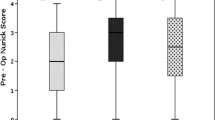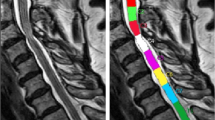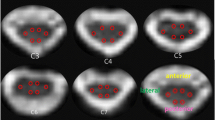Abstract
We examined whether or not high signal intensity change on magnetic resonance imaging of the spinal cord of patients with cervical myelopathy is related to the clinical symptoms and prognosis. Twenty-five patients with cervical myelopathy were treated by decompressive surgery which involved laminoplasty or decompressive anterior interbody fusion. The pathological conditions were cervical disc herniation (n = 8), ossification of the posterior longitudinal ligament in the cervical spine (n = 7), and cervical spondylotic myelopathy (n = 10). The spinal cord compression and the intramedullary signal intensity at the site of maximum compression were evaluated pre- and postoperatively using T1- and T2-weighted images. There was no significant relationship between spinal cord compressive change and clinical symptoms. Patients in whom the high signal change of the spinal cord on T2-weighted sequence recovered after decompressive surgery had better recovery from clinical symptoms, but a statistical significance was not found. We suggest that signal changes on T2-weighted images may reflect pathological changes but cannot be used to predict prognosis at present.
Similar content being viewed by others
References
Al-Mefty O, Harkey LH, Middleton TH, et al (1988) Myelopathic cervical spondylotic lesions demonstrated by magnetic resonance imaging. J Neurosurg 68:217–222
Batzdorf V, Flannigan B (1991) Surgical decompressive procedures for cervical spondylotic myelopathy: a study using magnetic resonance imaging. Spine 16:123–127
Fujiwara K, Yonenobu K, Ebara S, et al (1988) The prognosis of surgery for cervical compression myelopathy. J Bone Joint Surg [Br] 71-B:393–398
Fukushima T, Ikata T, Taoka Y, et al (1991) Magnetic resonance imaging study on spinal cord plasticity in patients with cervical compression myelopathy. Spine 16:S534-S538
Hackney DB, Asato R, Joseph PM, et al (1986) Hemorrhage and edema in acute spinal cord compression: demonstration by MR imaging. Radiology 161:387–390
Hashizume Y, Iijima S, Kishimoto H, et al (1984) Pathology of spinal cord lesions caused by ossification of the posterior longitudinal ligament. Acta Neuropathol 63:123–130
Haupts M, Haan J (1988) Further aspects of MR-signal enhancements in stenosis of the cervical spinal canal, MRI-investigations in correlation to clinical and cerebrospinal fluid findings. Neuroradiology 30:545–546
Hirabayashi K, Miyakawa J, Satomi K, et al (1981) Operative results and postoperative prognosis of ossification among patients with ossification of cervical posterior longitudinal ligament. Spine 6:354–364
Matsuda Y, Miyazaki K, Tada K, et al (1991) Increased MR signal intensity due to cervical myelopathy: analysis of 29 surgical cases. J Neurosurg 74:887–892
Mehalic TF, Pezzuti RT, Applebaum BI (1990) Magnetic resonance imaging and cervical spondylotic myelopathy. Neurosurgery 26:217–227
Nagata K, Kiyonaga K, Ohashi T, et al (1990) Clinical value of magnetic resonance imaging for cervical myelopathy. Spine 15:1088–1096
Ohshiro I, Hatayama A, Kaneda K, et al (1993) Correlation between histopathologic features and magnetic resonance images of spinal cord lesions. Spine 18:1140–1149
Ono K, Ota H, Tada K, et al (1987) Cervical myelopathy secondary to multiple spondylotic protrusions: a clinicopathologic study. Spine 2:109–125
Ramanauskas WL, Wilner HI, Metes JJ, et al (1989) MR imaging of compressive myelomalacia. J Comput Assist Tomogr 13:399–404
Takahashi M, Sakamoto Y, Miyawaki M, et al (1987) Increased MR signal intensity secondary to chronic cervical cord compression. Neuroradiology 29:550–556
Takahashi M, Yamashita T, Sakamoto Y, et al (1989) Chronic cervical cord compression: clinical significance of increased signal intensity of MR images. Radiology 173:219–224
Author information
Authors and Affiliations
Rights and permissions
About this article
Cite this article
Morio, Y., Yamamoto, K., Kuranobu, K. et al. Does increased signal intensity of the spinal cord on MR images due to cervical myelopathy predict prognosis?. Arch Orthop Trauma Surg 113, 254–259 (1994). https://doi.org/10.1007/BF00443813
Received:
Issue Date:
DOI: https://doi.org/10.1007/BF00443813




